Top Socks for Ballet Flats: Style Meets Comfort
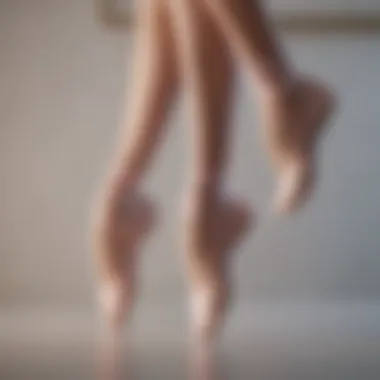
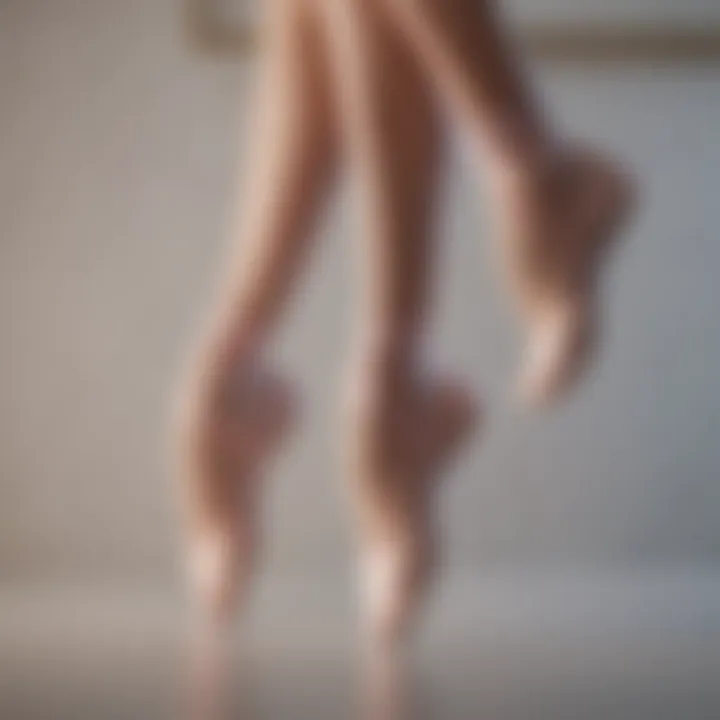
Intro
Finding the right socks for ballet flats can be a delicate balance of comfort, style, and function. Many women encounter the challenge of keeping their feet warm and protected while also maintaining an elegant appearance. This guide aims to dissect the factors influencing this choice, giving practical advice on suitable options for various occasions. Understanding the nuances of sock selection can elevate any ensemble, ensuring that your ballet flats look chic without sacrificing comfort.
Fashion Trends
Seasonal Styles
With changing seasons, the styles also shift. In warmer months, breathable options like cotton or bamboo fabric are ideal. These materials wick away moisture while providing comfort. In contrast, colder months might call for thicker fabrics, offering warmth without cramping the stylish profile of ballet flats.
- Spring/Summer: Lightweight ankle socks or no-show socks are often favored.
- Fall/Winter: Consider thicker, woolen socks that peek out slightly above the shoe line for a layered look.
Influencer Inspirations
Influencers play a significant role in dictating fashion choices today. Social media platforms showcase numerous looks combining ballet flats with styled socks, offering endless inspiration. To remain trendy, observe popular influencers and adopt their sock styles. Many opt for patterned or colorful socks that introduce an element of fun to the otherwise elegant ballerina shoe.
Comfort Considerations
When choosing socks specifically for ballet flats, comfort should not be an afterthought. The constructed architecture of ballet flats can necessitate socks that prevent blisters or discomfort.
- Look for socks with padded soles, which provide an extra layer of cushioning.
- Prioritize seamless designs, as they reduce friction points that can lead to irritation.
Sock Types and Fabrics
Understanding the various sock types available is essential in making an informed choice. Not all socks complement ballet flats equally.
- No-Show Socks: Ideal for maintaining the delicate appearance of ballet flats.
- Bamboo Socks: Naturally breathable and very soft; these are increasingly popular due to their comfort.
- Knee-High Socks: Depending on the style of ballet flats, knee-high socks can enhance the outfit when styled correctly.
Different fabrics serve different needs. Cotton is breathable but can absorb moisture. Wool offers warmth both in style and function.
Care Techniques
To prolong the life of your socks, especially those worn with ballet flats, care techniques are crucial. Proper washing and drying methods can help maintain sock quality over time.
- Washing: Always prefer cold water and mild detergent. This keeps colors vibrant and fabric soft.
- Drying: Avoid tumble drying. Lay flat to dry to prevent shrinkage or distortion of shape.
"The right socks can transform your ballet flats from a simple accessory to a statement piece. It’s all in the details."
The End
Prolusion to Socks for Ballet Flats
Socks for ballet flats are often an overlooked accessory that can make a significant difference in both comfort and style. The choice of socks can influence not only how the shoes fit but also how they look. Using socks with these shoes can enhance the overall aesthetic, providing a layer of warmth and protection while still maintaining the elegant appeal of ballet flats.
Considering the various activities one might engage in while wearing these shoes, it's vital to select socks that serve multiple functions. Proper socks can add cushioning, promote breathability, and prevent blisters. Furthermore, they can also help absorb moisture, which is essential when wearing footwear that often lacks proper ventilation.
In this article, we will delve into the attributes that make sock choices particularly relevant for ballet flats. We will explore material preferences, fit considerations, and how these socks can complement different occasions. The goal is to provide you with a complete understanding that balances aesthetic desire with practical uses. Overall, the right socks can ensure a comfortable experience without compromising the stylish essence of ballet flats.
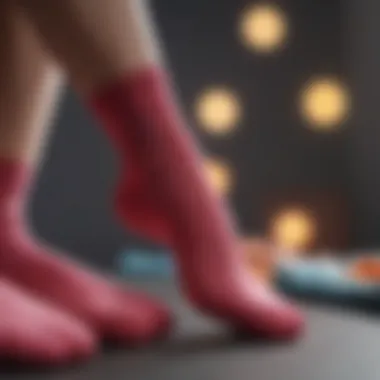
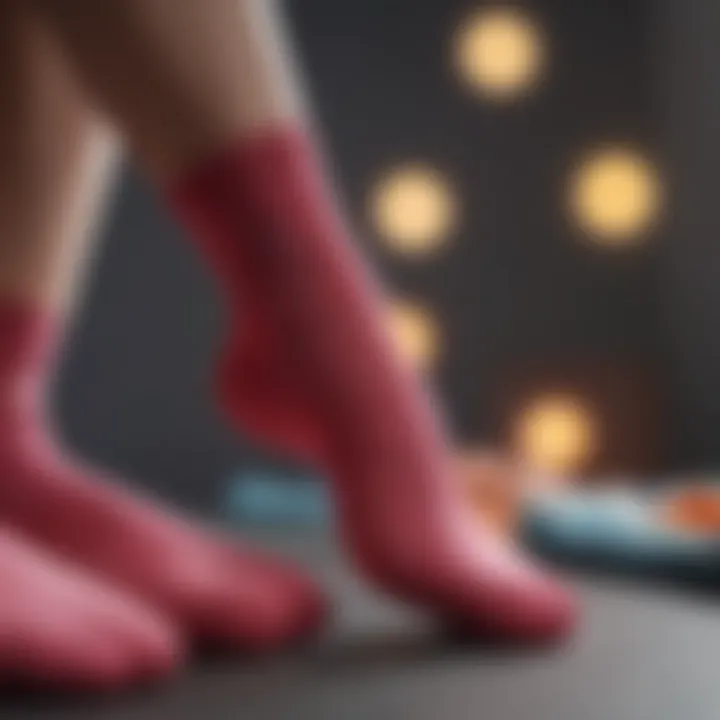
Understanding Ballet Flats
Ballet flats hold a significant place in women's fashion. They combine comfort and style, making them an ideal choice for daily wear. Understanding ballet flats involves recognizing their unique design, the materials used, and how they function in various situations. This section presents a thorough exploration of ballet flats, which is essential for selecting complementary socks. By grasping the essence of these shoes, you can make better choices that enhance both aesthetic appeal and comfort.
Design and Aesthetics
The design of ballet flats typically features a very sleek silhouette with a rounded toe. This simplicity lends them a distinct elegance, easily pairing with diverse outfits. Many ballet flats come in various colors and textures, allowing for personal expression. They are often crafted from leather, fabric, or synthetic materials. The aesthetic appeal of ballet flats makes them suited for both casual and formal settings.
Furthermore, the low-cut design highlights the ankles, providing a flattering look when paired with ankle pants or skirts. This aspect is crucial when choosing socks as their style must not interfere with the overall visual impression.
Why Socks Matter
The inclusion of socks with ballet flats is not merely a matter of warmth—it directly impacts comfort and style. Socks can prevent blisters, absorb moisture, and enhance cushioning around the foot. Without appropriate socks, the chances of discomfort, particularly during extended wear, increase significantly.
Moreover, socks can be a fashion statement in their own right. No-show socks provide a discreet option that maintains the clean line of the ballet flats while delivering comfort. Meanwhile, colorful ankle socks can serve as playful accents, adding character to the outfit.
In summary, understanding the role of both ballet flats and socks is fundamental. It allows for well-rounded choices that enhance an overall ensemble while prioritizing comfort and personal style.
Essential Features of Socks for Ballet Flats
Material Composition
Cotton
Cotton is one of the most popular materials for socks. Its softness and breathability are key attributes. Cotton allows for air circulation, helping to keep feet dry and comfortable during wear. This is particularly beneficial for those who spend long hours in ballet flats. The comfort of cotton can contribute to an enhanced experience, avoiding discomfort caused by prolonged use. However, it can retain moisture if not properly cared for, necessitating prompt washing and drying.
Bamboo
Bamboo is increasingly becoming a favored choice in the realm of socks. Its anti-bacterial properties make it a strong contender, as it helps to reduce odor and maintain hygiene. Bamboo's natural softness rivals that of cotton, providing a gentle touch against the skin. Its unique feature is the moisture-wicking ability, drawing moisture away from the skin. Though bamboo socks are often more expensive than cotton, their benefits can justify the cost for those who prioritize comfort and hygiene.
Synthetic Fibers
Synthetic fibers, such as polyester or nylon, bring durability to the table. They offer a snug fit that can enhance movement when wearing ballet flats. A key characteristic is their moisture management, which helps keep feet dry. Synthetic materials are often blended with natural fibers to amplify comfort, making them a versatile choice. However, they might lack the breathability of natural fabrics, which can lead to overheating in warmer conditions. Finding a balance in synthetic options is essential for maximizing the utility of socks worn with ballet flats.
Fit and Elasticity
The fit of socks is paramount when wearing ballet flats. Poorly fitting socks can cause discomfort and may even lead to blisters. Moreover, elasticity plays a role in ensuring that the socks stay in place, preventing them from slipping off the heel as one walks. It is important to choose socks with adequate stretch but that also hold their shape well over time. A sock that is too tight can constrict movement, while one that is too loose may bunch up, leading to an unsightly and uncomfortable experience. Selecting the right fit and elasticity will enhance the wearability of ballet flats.
Size and Thickness
Size is essential for achieving the best overall performance of socks when paired with ballet flats. Socks should complement the snug fit of the flats, so opting for a size that corresponds accurately to foot size is crucial. Thickness also matters significantly; thinner socks can provide a more streamlined appearance but may lack warmth and cushioning. On the other hand, thicker options provide added comfort but can alter the shoe fit. Therefore, understanding personal preferences regarding size and thickness will aid in making informed choices when selecting socks for ballet flats.
Popular Types of Socks for Ballet Flats
When it comes to wearing ballet flats, the right socks can make a significant impact on both comfort and style. Various types of socks serve different purposes, accommodating diverse preferences and occasions. Selecting the appropriate type can enhance the overall experience of flaunting these versatile shoes, ensuring they remain comfortable throughout the day while maintaining a fashionable appearance.
No-Show Socks
No-show socks are designed to be discreet and provide a bare-foot look, making them an ideal choice for ballet flats. Their main advantage is that they prevent discomfort from direct contact with the shoes. They come in various materials, including cotton and bamboo, allowing for breathability. This is crucial for temperature regulation, especially during warmer months.
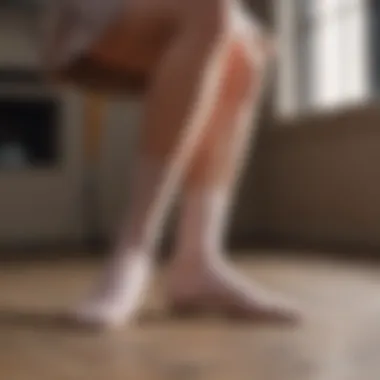
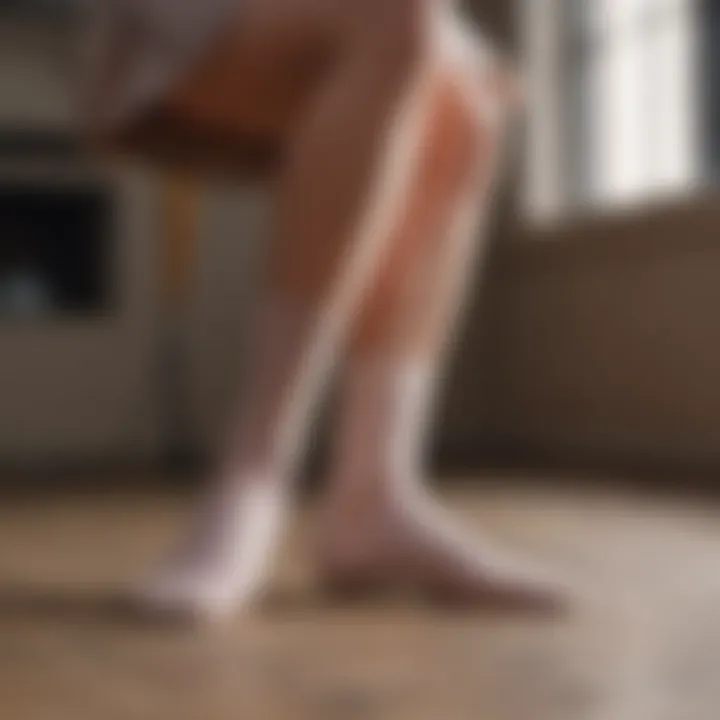
With a thin profile, no-show socks also maintain the sleek silhouette that ballet flats are known for. However, choosing the right size is essential; excessively loose or tight options may slip off the foot or create unsightly bulges. These socks are often equipped with silicone grips to keep them in place, ensuring a reliable fit throughout wear. Also, their low-cut design allows for versatility with different styles of ballet flats.
Ankle Socks
Ankle socks offer a slightly more visible option than no-show styles. Typically resting just above the ankle, they provide additional coverage while still remaining a stylish choice. Ankle socks can be especially beneficial during transitional seasons where temperatures fluctuate.
The cushioning in ankle socks can enhance comfort, making them suitable for day-long wear. This type is available in many colors and patterns, giving wearers the opportunity to express their personal style. They can be matched with various pant styles and skirts, allowing ballet flats to shine as a feature of the outfit.
Footies or Liners
Footies, or liners, are akin to no-show socks but tend to slightly cover more of the heel and sometimes the sides of the foot for added protection. These are particularly useful for preventing blisters and discomfort that often occur with ballet flats. They are designed to stay hidden and are often made of soft materials for optimal comfort.
Like no-show socks, footies help to wick moisture away, keeping feet dry and fresh. They add a layer of warmth, which can be essential during colder months, without compromising style. Footies can help maintain the lifespan of your ballet flats by minimizing sweat and dirt buildup, which can lead to faster wear and tear.
Style Considerations
When choosing socks to pair with ballet flats, style considerations play a crucial role. Many women gravitate towards ballet flats for their elegance and versatility. However, integrating socks properly is essential to maintain that refined aesthetic. The right socks not only enhance the overall look but also cater to individual taste and occasion.
Color Coordination
Color coordination is a fundamental aspect when selecting socks for ballet flats. The color of the socks should complement or contrast smartly with the shoes. For instance, if you opt for classic black ballet flats, white socks can create a classic look, while colorful socks can add a playful touch. Choosing neutral colors like beige or gray might streamline the outfit while keeping it sophisticated.
"The harmony between socks and shoes can significantly impact your overall style."
One strategy is to consider the overall outfit color scheme. If you wear a patterned dress, a solid color sock may work better to avoid visual clutter. Alternatively, if the outfit is monochromatic, a patterned sock can inject some personality into the ensemble.
Texture and Patterns
Texture and patterns hold the same weight as color in style considerations. Different textures can add depth and interest to the outfit. For example, a pair of ribbed socks might add a cozy touch when paired with ballet flats during colder months. Likewise, lace or netted socks offer a more delicate aesthetic, suitable for a dressy occasion.
Patterns can also express personality and playfulness. Polka dots, floral prints, or stripes can dictate the tone of an outfit. If you wear ballet flats for casual outings, fun patterns can emphasize a carefree vibe. In contrast, more subdued patterns may be apt for professional environments.
When selecting socks, consider also the level of visibility—do you want the socks to be a focal point or a subtle accent? A balanced approach with well-thought-out coordination will allow for a refined look that marries aesthetics with utility.
Occasions to Wear Ballet Flats with Socks
Understanding the various occasions to wear ballet flats with socks is crucial. The right socks can elevate an outfit, providing both comfort and style. This adaptability ensures women can enjoy wearing their ballet flats while maintaining an appropriate look for different events. The choice of socks can influence the overall tone, whether it be casual or formal, and plays a significant role in overall comfort and foot health.
Casual Outings
For casual outings, pairing ballet flats with socks can be quite practical. This combination not only adds a layer of warmth but also improves comfort during extended periods of walking. Many women choose no-show socks or thinner footies that remain hidden while providing necessary support. The light cushioning can also help prevent blisters, making them ideal for running errands or meeting friends for coffee.
Appropriate sock colors for casual settings can often lean towards neutral or pastel shades, aligning with everyday wear. Socks with subtle patterns may add a touch of flair without overwhelming an outfit. Wearing ballet flats in this way promotes a laid-back yet thoughtful aesthetic.
Formal Events
When it comes to formal events, wearing socks with ballet flats becomes more nuanced. While the traditional view is to forgo socks entirely, certain sock styles can enhance elegance. For instance, sheer ankle socks or decorative tights can offer sophistication while showcasing the shoes. When opting for an elegant look, pay attention to materials. Silk or lace socks can provide a delicate touch suitable for events like weddings or formal dinners.
Pairing ballet flats with these sophisticated socks can be a way to express personal style while adhering to decorum. It also offers added warmth during cooler evenings, ensuring comfort without sacrificing elegance.
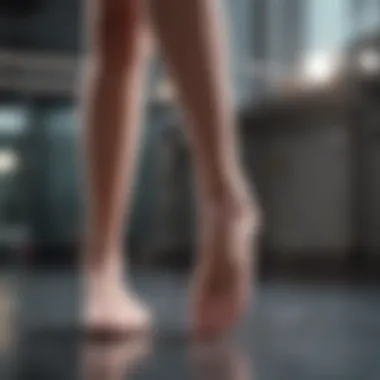
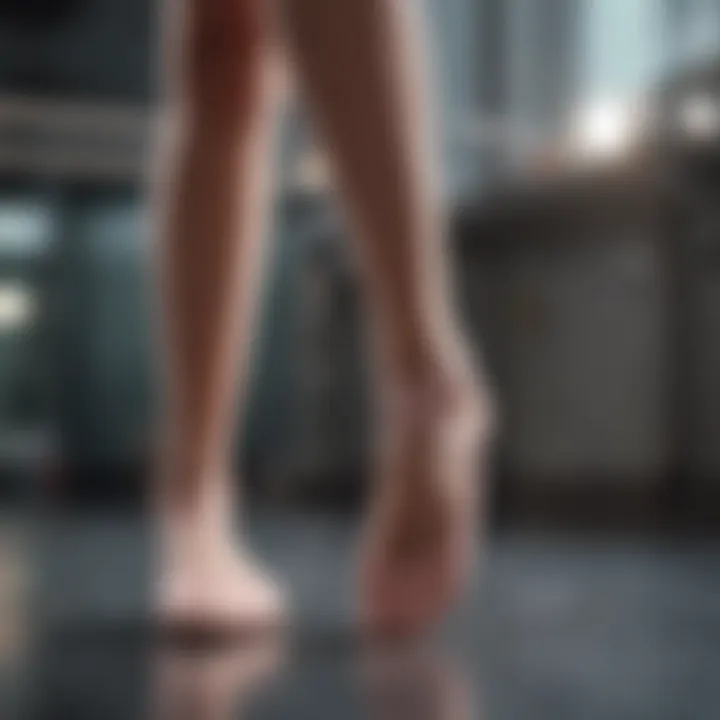
Seasonal Adaptations
Seasonality significantly influences the choice of socks to wear with ballet flats. In warmer months, lightweight and breathable materials such as cotton or bamboo work well to keep feet cool. No-show socks are a popular choice, ensuring feet remain unseen while providing a layer of protection.
In colder seasons, thicker socks become essential. Wool blends can add insulation while maintaining the fashionable appearance of ballet flats. Transitioning between seasons may also call for different patterns or colors to align with seasonal palettes. Choosing darker tones in the winter and lighter or brighter shades in spring and summer can create a visually appealing ensemble.
Ultimately, being mindful of seasonal shifts can help women effectively incorporate socks into their ballet flat outfits, enhancing both comfort and style.
Comfort and Performance
When choosing socks for ballet flats, considering comfort and performance is critical. These elements directly affect the wearer's experience, ensuring that the footwear remains enjoyable throughout various activities. Socks designed for ballet flats should offer support and ease, which are essential for prolonged wear.
Cushioning and Arch Support
Cushioning in socks provides additional comfort, especially for those who spend extended periods on their feet. A well-cushioned sock helps absorb impact, reducing fatigue. This is particularly important when wearing ballet flats, as they often lack substantial support.
In addition to cushioning, arch support plays a vital role. Socks with built-in arch support can help distribute weight evenly across the foot, preventing discomfort. Good arch support is essential for maintaining proper posture and reducing the risk of strain during daily activities. Women of all ages must prioritize socks that offer these features to enhance their overall foot health.
Breathability and Moisture-Wicking
Breathability is another crucial element to consider when selecting socks. Socks made from breathable materials help maintain airflow, which is essential for keeping feet dry and comfortable. This is especially true on warmer days or during physical activities, where excess heat and sweat can lead to discomfort.
Moisture-wicking capabilities are also significant. Socks designed with moisture-wicking technology draw sweat away from the skin, keeping feet drier for longer periods. This reduces the likelihood of blisters and other foot irritations, making the overall experience more pleasant. For optimal comfort when wearing ballet flats, choose socks that incorporate both breathability and moisture-wicking properties. This ensures that feet not only feel comfortable, but remain healthy.
Caring for Your Socks
The way you care for your socks can greatly influence their performance and lifespan. This section elaborates on the importance of proper sock care, including washing and storage techniques. Investing time in these tasks ensures your socks not only remain hygienic but also retain their functionality and style.
Washing Guidelines
When it comes to washing socks, different fabrics require varying care. Here are some critical considerations:
- Read the Care Labels: Always check the specific washing instructions provided on the care label. This ensures you use the correct temperature and washing method.
- Cold Water: Generally, washing socks in cold water preserves the integrity of the fabric. This method helps to prevent shrinking and fading.
- Gentle Cycle: Use a gentle cycle on your washing machine. This mode minimizes agitation, reducing wear and tear.
- Separate Colors: To maintain color vibrancy, wash darker colors separately from lighter ones. This practice prevents color bleeding that can happen during the wash.
- Avoid Fabric Softener: Fabric softeners may reduce moisture-wicking properties. Instead, consider using a vinegar rinse as a natural alternative.
- Air Dry: If possible, air drying is recommended over machine drying. Hang socks or lay them flat to dry. This ensures they keep their shape and elasticity.
By taking these washing steps, you extend the life of your ballet flat socks and maintain their comfort and fit.
Storage Tips
Proper storage helps to maintain the structure and hygiene of your socks. Here are some suggested practices:
- Cool, Dry Environment: Store your socks in a cool, dry place. Avoid damp areas that may encourage mildew growth.
- Avoid Folding: Instead of folding, stack your socks flat. This method avoids direct pressure on the elastic and helps in maintaining their shape.
- Use Organizers: Consider using drawer dividers or organizers to keep your socks sorted. This makes it easier to find the pair you want and reduces the risk of losing them.
- Regular Rotation: Rotate your socks. This means regularly wearing different pairs to prevent uneven wear. Over time, some socks could age faster than others.
- Monitor for Damage: Regularly check your socks for holes or wear. Addressing these issues quickly can save you from making unnecessary purchases.
Regular care and proper storage can significantly improve the durability of your socks, ensuring they serve you well for many outings.
Culmination
In summarizing this comprehensive guide on socks for ballet flats, it is vital to underscore several key elements that enhance both function and aesthetic. First, you have explored the importance of material composition, where options like cotton, bamboo, and synthetic fibers play a significant role in comfort and breathability. Choosing the right fabric ensures that your feet stay comfortable, particularly during extended wear.
The types of socks you select, whether they are no-show socks, ankle socks, or footies, significantly affect how your ballet flats fit and feel. Each type comes with its distinct advantages depending on the occasion and personal style. For instance, no-show socks work perfectly for a sleek look, while ankle socks can introduce a playful twist to your outfit.
In discussions about style considerations, the significance of color coordination and patterns cannot be ignored. These elements allow for a unique expression of personal style while maintaining a cohesive look with ballet flats. Incorporating socks into your outfit also opens up diverse styling avenues, matching different occasions from casual to formal.
Additionally, comfort parameters such as cushioning and arch support are essential for ensuring that your feet remain comfortable throughout your day. By investing in high-quality socks designed with these features, you can enhance your overall experience when wearing ballet flats.
Finally, caring for your socks correctly extends their life, reflecting your attention to detail in maintaining your fashion choices. Simple washing guidelines and proper storage techniques help preserve the integrity and appearance of your socks, allowing you to maximize both their utility and style for years to come.



